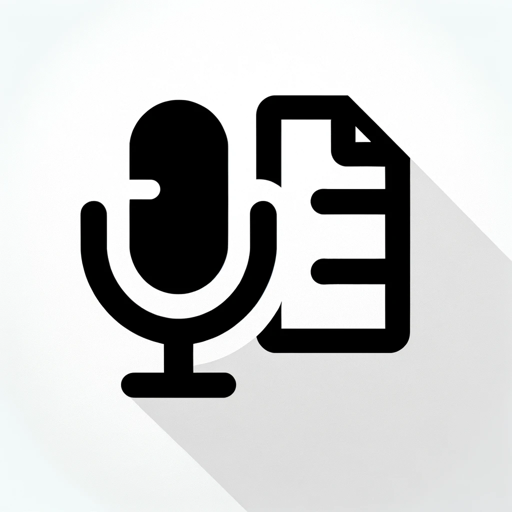Speech to Text-AI-powered speech to text.
AI-Powered Speech to Text Transcription.
Related Tools
Load More
Speech to Text PRO
Transcribes speech to text with expertise.

Text To Speech
I elevate your text into impactful speech with deep meaning. "People will forget your words, but they will always remember, how those forgotten words made them feel."

Voice to Text
An academic-focused voice-to-text assistant for college students.

Audio to text
Expert en transcription audio en texte
Voice-To-Text Notes
Voice-To-Text Note Taking converts spoken words into written text instantly. Ideal for meetings and lectures, it enhances productivity by enabling hands-free, accurate note transcription and easy organization of key information.

Voice Engine Text To Speech
Converts text to speech, max 4096 chars, 6 voices
20.0 / 5 (200 votes)
Introduction to Speech to Text
Speech to Text (STT) technology, also known as voice recognition or speech recognition, is designed to convert spoken language into written text. This technology is based on sophisticated algorithms that analyze the sound waves produced during speech and match them with corresponding text representations. Speech to Text systems utilize natural language processing (NLP) and machine learning models, which have been trained on vast datasets of human speech to understand and transcribe words accurately. The primary purpose of Speech to Text is to facilitate the transformation of spoken communication into a digital format that can be used in various applications. For example, a person might use STT to dictate a text message instead of typing it, or a company might deploy it to transcribe customer service calls for quality analysis.

Main Functions of Speech to Text
Real-time Transcription
Example
A journalist can use STT during a live press conference to capture spoken words as written text instantly.
Scenario
In a fast-paced environment like a press conference or a live interview, typing out everything verbatim is not feasible. Real-time transcription allows the journalist to focus on the event without worrying about missing important details.
Automated Transcription of Audio/Video Content
Example
A podcaster can automatically convert their recorded episodes into text transcripts for publishing.
Scenario
Podcasters often need transcripts of their episodes for accessibility, SEO, or content repurposing. Instead of manually transcribing hours of content, STT can handle the task efficiently, allowing creators to focus on other aspects of production.
Voice Command Processing
Example
A user can control smart home devices using voice commands that are recognized and executed by STT systems.
Scenario
In smart homes, Speech to Text technology enables users to interact with devices through voice. For instance, saying 'turn off the lights' can be processed by the system to execute the command, making daily tasks more convenient and accessible.
Ideal Users of Speech to Text Services
Individuals with Disabilities
Speech to Text services are highly beneficial for individuals with physical disabilities that prevent them from using traditional input devices like keyboards. For example, people with limited mobility can use voice commands to write documents, send emails, or browse the internet, enhancing their independence and productivity.
Professionals in Content Creation and Journalism
Content creators, journalists, and researchers often need to quickly convert spoken interviews, discussions, or ideas into text. STT allows them to focus on the creative process without the time-consuming task of manual transcription, enabling faster turnaround times for publishing and analysis.

How to Use Speech to Text
Step 1
Visit aichatonline.org for a free trial without login, no need for ChatGPT Plus.
Step 2
Ensure that your microphone is properly connected and functioning. You may need to adjust your system’s microphone settings for optimal performance.
Step 3
Once on the site, select the Speech to Text option from the available tools or features.
Step 4
Begin speaking clearly into your microphone. The tool will transcribe your speech into text in real-time. Speak at a moderate pace to ensure accuracy.
Step 5
Review the transcribed text for any minor errors and make adjustments as needed. Use the copy or download options to save your work.
Try other advanced and practical GPTs
Speech to Text Companion
AI-powered transcription made easy

Speech-to-Text Transcript Recap
AI-powered detailed meeting minutes.

Blackjack Wizard
AI-powered Blackjack mastery tool.

AI Doctor
AI-driven medical insights at your fingertips

Zettelkasten Fleeting Note Creator For Obsidian
AI-Powered Zettelkasten Note Creator for Obsidian

SEOアシスタント
AI-powered SEO optimization for websites

Speech to Text PRO
AI-Powered Speech Recognition for All

統計検定2級_作問&解説
AI-powered statistical exam preparation.

Dirt Bag Airman, an Airforce Writing Assistant
AI-powered Air Force bullet writing assistant

Wine Sommelier
AI-powered wine expertise at your service

Wine Specialist
Your AI-Powered Wine Guide

Anime Artist
AI-powered photo to anime converter

- Academic Writing
- Content Creation
- Meeting Notes
- Hands-Free Writing
- Real-Time Transcription
Common Questions About Speech to Text
What is the main purpose of Speech to Text?
The main purpose of Speech to Text is to convert spoken language into written text quickly and accurately. It is especially useful for those who need to transcribe conversations, take notes, or write hands-free.
What types of devices are compatible with Speech to Text?
Speech to Text can be used on a variety of devices including desktops, laptops, tablets, and smartphones. It works best with devices that have a high-quality microphone.
Can Speech to Text recognize different languages or accents?
Yes, Speech to Text supports multiple languages and can recognize a wide range of accents. However, the accuracy may vary depending on the clarity of speech and the language model available.
How secure is my data when using Speech to Text?
Your data is processed securely, with strict adherence to privacy standards. Transcriptions are typically not stored, ensuring that your information remains confidential.
Are there any usage limitations for the free version of Speech to Text?
The free version offers full functionality without the need for a ChatGPT Plus subscription, though it may have time limits or other minor restrictions compared to premium options.